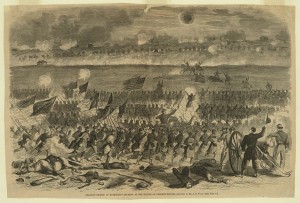I’m grateful to my Library of Congress colleague Anne Savage for providing today’s guest post. Anne supports K-12 teachers by developing classroom materials and providing professional development.
When is the pencil mightier than the camera? When it is recording the action on a Civil War battlefield.
Today’s war correspondents include photographers and videographers, whose images and films are transmitted almost instantly to our homes. But who recorded the action during the Civil War, when the technology of cameras was too slow to capture people in motion?
Your students may be surprised to discover the answer: artists. Alfred Waud, Edwin Forbes and other sketch artists were assigned to the battlefield by illustrated newspapers like Harper’s Weekly. Their weapons were pencil, paper and paintbrush, and they put their lives on the line just like today’s war correspondents to depict camp life, marches, battles and important events of the U.S. Civil War.
Recently, I was taken aback to realize that, prior to discovering the Library’s Civil War sketches, most of the images I had seen of the war were stationary photographs. I wondered how this influenced my views on the war.
Now, the sight of falling horses, flailing swords and suffering soldiers – as witnessed firsthand by a Civil War sketch artist – communicates a vivid and personal sense of what it was like to be in the middle of combat during this terrible war.
Teaching Ideas
Compare Alfred Waud’s “Gallant Charge” with a Mathew Brady photograph of the same battlefield, then brainstorm about the differences between the two images. What can you learn from one that you can’t learn from the other? What are the advantages and disadvantages of each format? What was each creator able to experience and depict that perhaps the other wasn’t?
Have each student choose a Civil War sketch by Alfred Waud, then write a “letter home” about the event depicted from the point of view of the artist or a soldier.
Have students examine the photo of Alfred Waud and compare his equipment and his daily life with that of today’s wartime photographer.
Additional Resources
You’ll find sketches by Waud and other artists in the Library’s Morgan collection of Civil War drawings.
You can use the Library’s primary source analysis tool and teacher guides to help students analyze these primary sources in further depth.
How could you incorporate eyewitness sketches in your own classroom? We’d love to hear how you think these drawings might help your students make connections to the past.


